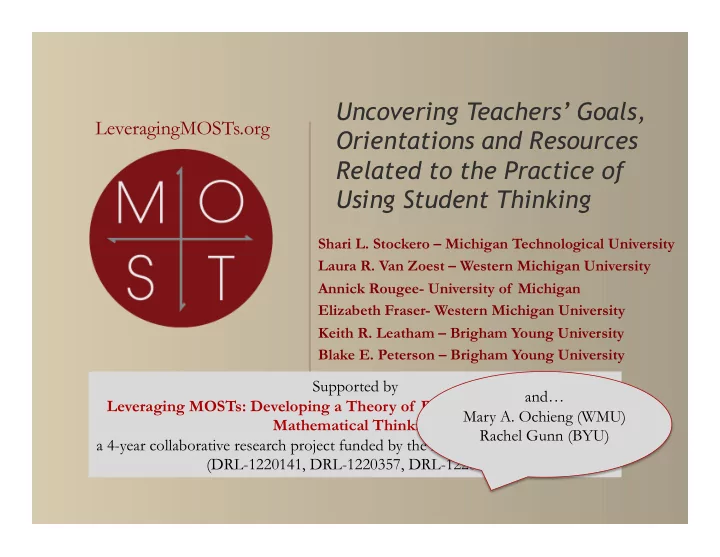

Uncovering Teachers’ Goals, LeveragingMOSTs.org Orientations and Resources Related to the Practice of Using Student Thinking Shari L. Stockero – Michigan Technological University Laura R. Van Zoest – Western Michigan University Annick Rougee- University of Michigan Elizabeth Fraser- Western Michigan University Keith R. Leatham – Brigham Young University Blake E. Peterson – Brigham Young University Supported by and… Leveraging MOSTs: Developing a Theory of Productive Use of Student Mary A. Ochieng (WMU) Mathematical Thinking Rachel Gunn (BYU) a 4-year collaborative research project funded by the National Science Foundation (DRL-1220141, DRL-1220357, DRL-1220148)
Understanding the Practice of Using Student Thinking • To support teachers in enhancing this practice, we need to better understand teachers’ reasoning about the practice • Previously used classroom observations and recordings: – Insufficient data to make certain inferences – Difficult to make comparisons among the practices of teachers who are teaching different content, in different contexts, with different student responses • Developed a scenario-based interview (Scenario Interview) What does the Scenario Interview tool afford us?
The Scenario Interview Purposes and Affordances: • Compare teachers’ responses to same instances of student thinking • Capture teachers’ thinking about attending to student thinking • Infer teachers’ goals, orientations, and resources (GOR) (Schoenfeld, 2011)
Theoretical Framework • Schoenfeld’s (2011) theory of goal-oriented decision making – Goals: short or long-term; may relate to the learning of specific content, broader outcomes, or teacher actions – Orientations: include teachers’ “dispositions, beliefs, values, tastes and preferences” – Resources: everything a teacher could access to support instruction (e.g., physical materials; teachers’ knowledge of mathematics content and typical student conceptions) Student Thinking as a Resource
Interview Format • Teacher presented with instance of student thinking • Interviewee situated as the teacher • Contextual information not given, but can be requested • Interviewee asked to describe what they might do next • Follow up questions probe the teacher’s decision, rationale, possible assumptions, and use of contextual information
Sample Instance of Student Thinking Chris shares the following solution: “The radius of the big circle is 5 and the radius of the little circle is 3, so the gap is 2, so the area of the band is 4 pi cm 2 .” 3 ¡cm ¡ 5 ¡cm ¡
Analysis • Unit of analysis: teacher statements • Coded for goals, orientations, and resources • Reconciled codes • Grouped into themes • Compared themes across teachers
Ms. Shaw considers student thinking as a resource for... • making instructional decisions : – She wonders “Can they talk through it? Or is it something that's going to come up later on, maybe later in the lesson, maybe next class period. Is someone going to bring that up for me ?” (I13) – “And then if that's truly where he's headed, then I want to go back and revisit the problem and say, 'Ok, so let's talk about how you're getting 4 pi. You're assuming it's the radius of the circle.’ “ (I7) • helping students make sense of the mathematics in a lesson : – Responses to questions such as “Why are you using [2] as your radius?” (I5) as opportunities for students to “start to see yes it's a difference of 2 but it's not a circle of a radius of 2 ." (I5)
Goals, Orientations and Resources Student Thinking as a Goals for Using Student Orientations toward Student Resource Thinking Thinking confirm correct answers to accomplish what she she is responsible for explaining and address Ms. Dean wants to happen during and demonstrating mathematical misconceptions in a lesson ideas to students incorrect answers to make instructional decisions and to help students need ample time and engage students in sense- students make sense of opportunities to think about Ms. Shaw making mathematical ideas the mathematics in a lesson to position the students as thinkers by providing position students as students can learn through Mr. Mead them with opportunities mathematical thinkers mathematical exploration to share their thinking
Goals, Orientations and Resources Student Thinking as a Goals for Using Student Orientations toward Student Resource Thinking Thinking confirm correct answers to accomplish what she she is responsible for explaining and address Ms. Dean wants to happen during and demonstrating mathematical misconceptions in a lesson ideas to students incorrect answers to make instructional decisions and to help students need ample time and engage students in sense- students make sense of opportunities to think about Ms. Shaw making mathematical ideas the mathematics in a lesson to position the students as thinkers by providing position students as students can learn through Mr. Mead them with opportunities mathematical thinkers mathematical exploration to share their thinking
Goals, Orientations and Resources Student Thinking as a Goals for Using Student Orientations toward Student Resource Thinking Thinking confirm correct answers to accomplish what she she is responsible for explaining and address Ms. Dean wants to happen during and demonstrating mathematical misconceptions in a lesson ideas to students incorrect answers to make instructional decisions and to help students need ample time and engage students in sense- students make sense of opportunities to think about Ms. Shaw making mathematical ideas the mathematics in a lesson to position the students as thinkers by providing position students as students can learn through Mr. Mead them with opportunities mathematical thinkers mathematical exploration to share their thinking
The Scenario Interview data allows us: • To make inferences about what a teacher’s practice might look like • To understand the possible reasoning behind the teacher moves that we might observe during a lesson • To understand why different uses of student thinking might make sense to different teachers based on the GOR that underlie their practice • To perceive distinctions among teachers
Any questions?
Recommend
More recommend